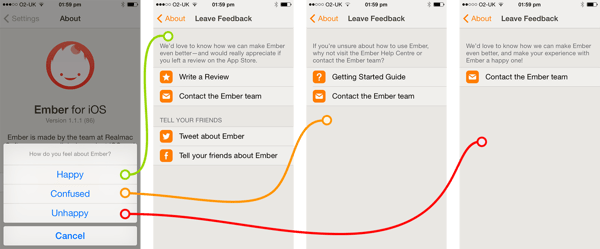
How to make users want your app? — Ratings and reviews

.png)
If you’re building an app, you probably know that one of the things you should really care about are your ratings and reviews. Obviously you don’t have full control over them but what you can do is encourage more and better ratings.
The first thing you should do is… build a great app! That always works. But sometimes even the greatest apps struggle to get good ratings. What can you do to make more users rate and review your app?

Why are ratings and reviews so important?
You may think that if your app is good and solves users’ problems, it will just naturally get popular. But it doesn’t always work this way. Sure, there are some apps that go viral but usually it takes some work to get discovered. In the crowd of over 1.5 million apps it’s really easy to get lost, even with a great app.
Marketing is important and there are ways to get more downloads by investing enough money but the truth is that other users’ opinions always mean more to your potential users than any of your ads. Look at it this way — when buying a new car would you trust the salesman who earns on selling it to you or other people who already bought this car? In a perfect world, recommendations come from friends, those are most valuable, but unfortunately that doesn’t happen that often.
Research from Princeton confirms how powerful social influence is — see Salganik, Dodds, Watts (2006) “Experimental Study of Inequality and Unpredictability in an Artificial Cultural Market”. In their experimental conditions, there can even be a “winner takes all” market, with the winner depending strongly on what gets recommended in the first round of feedback.*
Because ratings and reviews are important to users, the App Store and Google Play treat it as one of the most important factors for displaying apps in search results. App stores aim to display apps that users will be happy with, and that’s why factors that influence app positions are mainly those you can’t control but indicate how users feel about your app (ratings, number of installs vs uninstalls, active users etc.).
So the thing is — a great app and continuous app store optimisation are both equally important for your success but it’s gonna be a lot harder without good ratings and reviews. And it is (in a way) up to you if you’re gonna get them. Keep in mind that your rating not only influences your positions but above all it influences the decisions of people viewing your app store page. If your app doesn’t have enough ratings and reviews to be displayed, it seems like nobody is using it and if the rating is low, it usually means it’s not worth downloading it.
Even if users download your app, low ratings and bad reviews may cause them to be less interested in getting to know it.
When to ask?
The biggest mistake you can make when asking for a review is ask for it at a bad moment.
What you have to keep in mind — always — is who your app is for. Your main goal may not be creating a great tool just because you love solving people’s problems, you may even do it solely to earn money on your product, and it’s fine, but your app is for your users and if you don’t put their experience first, your success is not gonna come. Here’s where in my experience most apps do it wrong.
Some developers want their ratings so badly, they ask too soon, before a user knows the app well enough to feel like rating and writing a review about it and this usually ends up in low ratings or no ratings at all.
What you need to look for is a point in your app that is a natural pause in your users’ experience. Whether it’s the end of a chapter of your game, a successful payment, completion of an e-learning course etc. you should always ask for rating AFTER a user has completed the main action of your app and is satisfied with the outcome. Asking for a rating after losing a game, crash or error message may not be the best idea.
To make sure a user is truly a fan of your app, you should also ask for ratings after she opened and used your app at least few times. If she’s there for the first time, even if she completed the action, it doesn’t mean she likes the app. Remember that completing an action during onboarding, with your tips, should not be counted as a successful app experience. It will cause less users to get the request but it’s not a bad thing.
Limiting the number of users you ask for review and rating only to those who actually like using your app will make the process bit longer but it’s worth it to build your position. It’s impossible to give one template for when you should ask users for their opinion, it all depends from the way your app works. If you’re not sure what will be the best time to do it, test a few options and compare the results over time.
How to ask?
Now you know when you should ask but how to do it? You can of course just display a native popup asking for a rating and review but trust me, users hate it. Users generally hate popups, especially if they can’t easily turn them off. If there’s a way to incorporate a request for rating in your app experience, always try to do it this way. Great example of this approach is Circa News app that added a rating request section to their news feed. This way the user’s experience is not interrupted and she can easily ignore your request if she’s not ready for it. It doesn’t sound like a way to increase number of ratings but trust me, users appreciate it when you respect them.
A great way to improve your official rating is double request. A lot of apps are doing it now and you should too. Asking for an internal rating first and then asking for an app store rating only from happy users will give you a chance to control your ratings.

Users who are not happy with their experience can get a request to send you feedback so you know what’s wrong with the app before they leave a negative review. This is the way Circa News and Ember does it and it works great. It’s really easy. Ask users if they like your app, if they do, ask them for rating, if they don’t, ask for feedback (Ember added a “confused” option, you can consider it if your app is complicated).

Tinder
On the other hand, Tinder tries to do the same, asking for an internal rating first but with a popup that can’t be turned off without filling the stars first and that’s really annoying.
Forcing users to do anything is never good and it may cost you some bad reviews.
Just think how to avoid annoying your users. Maybe you will get less reviews and it will take bit more time than by forcing users but these reviews will for sure be better and more valuable for you.
Another thing is adjusting the message to suit your app.
If your app is for professionals and the language you use in the app is official, keep it t he same way.
If it’s fun, make your request fun as well. Make it consistent with the app so the user doesn’t feel like she’s dealing with something outside of your app. Make it easy to reach out to you — some users will not be happy with your app or they will miss some features you might not thought off yet. Even if they didn’t have a chance to see your rating request yet, they may still go to your app store page and post a negative review. You can avoid this by making it easy to contact you directly. It doesn’t mean you will never get any negative reviews but if users have a way to complain without making it public, you will probably get less low ratings.
What if you get a negative review though? It’s also a good thing!
Sure, it doesn’t look great on your app store page but it lets you understand what users need and can guide you to improve your app with updates.
Summary
As I said before, you may not have full control over your ratings and reviews but that’s not a reason to overlook them. On the contrary, you should make sure you’re doing everything right in this matter. Test your approach and learn from it, see what users like and what annoys them, adjust the requests from your app and please… don’t beg and don’t force! Make it feel as natural as possible. Remember to put users first. Just try it all out and see the difference yourself, because you will see it.
